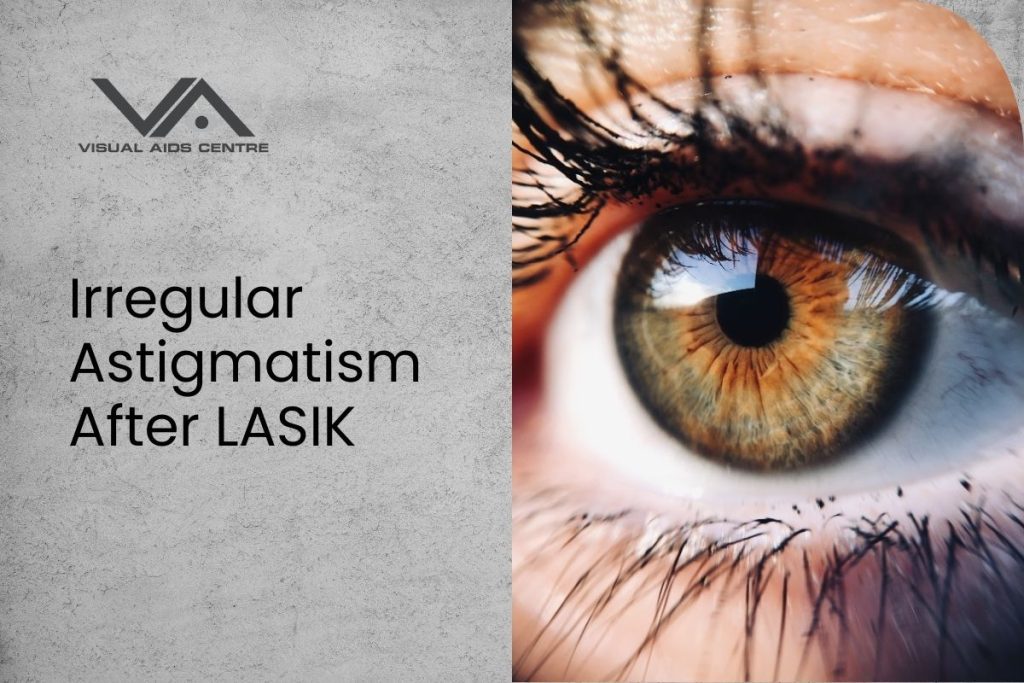Table of Contents
Toggle
LASIK surgery is seen as safe and effective for correcting vision problems. It helps people reduce their need for glasses or contact lenses. But, like any surgery, LASIK can have risks and complications. One of these is irregular astigmatism, a condition that affects the cornea’s shape and smoothness.
It’s important to understand irregular astigmatism and its possible link to LASIK. This guide will look at the causes, symptoms, how to diagnose it, and treatment options. It aims to help people make informed decisions about their eye health.
Understanding Irregular Astigmatism After LASIK
Irregular astigmatism happens when the cornea is unevenly curved. Unlike regular astigmatism, where the curve is consistent, irregular astigmatism has random curves. This can cause big problems with vision after LASIK, making everyday tasks hard.
Even with modern LASIK, irregular astigmatism can sometimes happen. It’s more likely if the surgery doesn’t go perfectly. Knowing about its causes and symptoms is key for early diagnosis and treatment.
Causes of Irregular Astigmatism After LASIK
Several things can lead to irregular astigmatism after LASIK:
- Decentered Ablation: A big cause is when the laser treatment doesn’t line up right with the pupil’s center. This leads to uneven reshaping of the cornea, causing irregular curvature and astigmatism.
- Corneal Flap Issues: The corneal flap is a critical part of LASIK. Any problems with making this flap, like uneven thickness or wrinkles, can cause corneal irregularities.
- Laser Calibration and Treatment Accuracy: Sometimes, technical issues like laser calibration problems can also cause uneven reshaping of the cornea, leading to irregular astigmatism.
- Healing Responses: Everyone heals differently after LASIK. If the corneal tissue heals unevenly, it can make astigmatism worse.
Recognizing Symptoms of Irregular Astigmatism
Irregular astigmatism after LASIK can show in several ways, including:
- Blurry or distorted vision that doesn’t get better with glasses or contacts.
- Visual problems like ghosting, double images, or shadowing.
- Glare and halos around lights, which can be a big problem at night, making driving hard.
- Eye discomfort or headaches from trying to see clearly.
Spotting these symptoms early is key to getting the right treatment quickly.
Diagnosing Irregular Astigmatism
To accurately diagnose irregular astigmatism after LASIK, several tests are needed:
- Corneal Topography: This imaging technique maps the cornea’s surface, showing where it’s uneven and giving a detailed shape assessment.
- Wavefront Aberrometry: This test measures how light travels through the eye, finding small vision problems that other tests might miss.
- Slit-Lamp Examination and Refraction Tests: Eye exams with a slit-lamp microscope help doctors check the cornea’s shape and overall eye health.
These tests help doctors diagnose irregular astigmatism accurately and plan the best treatment.
Treatment Options for Irregular Astigmatism After LASIK
Dealing with irregular astigmatism after LASIK depends on how bad the symptoms are and the health of your cornea. There are two main types of treatments: surgical and non-surgical.
Surgical Approaches
- Topography-Guided LASIK Enhancement: This advanced procedure uses detailed corneal maps for precise correction, better than standard LASIK.
- Photorefractive Keratectomy (PRK) with Mitomycin C: PRK reshapes the cornea’s surface without a flap. Using Mitomycin C reduces haze risk, improving results and stability.
- Corneal Cross-Linking: This strengthens the cornea, stabilizing its shape. It can improve vision when irregularities are mild to moderate.
Non-Surgical Approaches
- Specialty Contact Lenses: Custom rigid gas-permeable or scleral lenses can greatly improve vision. They provide a smooth surface, hiding corneal irregularities.
- Corrective Eyewear: In milder cases, glasses or soft contact lenses might help. But their effectiveness can vary.
Managing Recovery and Follow-Up
A good recovery plan is key for healing well and avoiding problems:
- Adhering to Surgeon’s Instructions: Use eye drops as prescribed to lower infection risk and aid healing.
- Regular Follow-Up Appointments: Regular check-ups let surgeons monitor healing and catch issues early. They can adjust treatments as needed.
- Timely Intervention: Catching irregular astigmatism early improves treatment success and vision recovery.
Prevention of Irregular Astigmatism
Steps taken before LASIK can lower the risk of irregular astigmatism:
- Accurate Corneal Mapping: Advanced technologies like topography and wavefront analysis help plan surgery precisely for each patient.
- Advanced Surgical Techniques: Modern LASIK methods, like wavefront-guided or topography-guided, offer better precision and outcomes, reducing irregularities.
- Experienced Surgical Team: Choosing skilled surgeons with the latest technology and techniques is important. It reduces complications and improves results.
When to Seek Immediate Medical Attention
Watch for any sudden changes in vision after surgery. Seek immediate help for severe vision loss, intense pain, or other alarming symptoms. Early action can prevent lasting damage and improve treatment success.
Conclusion
Knowing about the risk of irregular astigmatism after LASIK helps patients make informed choices. While rare with today’s methods, acting quickly on symptoms is key.
There are many ways to manage irregular astigmatism, including surgery and non-surgery. Following post-op care, attending regular check-ups, and taking preventive steps can help achieve the best vision and reduce risks.
Keeping in touch with eye care professionals and actively managing eye health empowers LASIK patients. This way, they can get the best vision and life satisfaction after their surgery.













